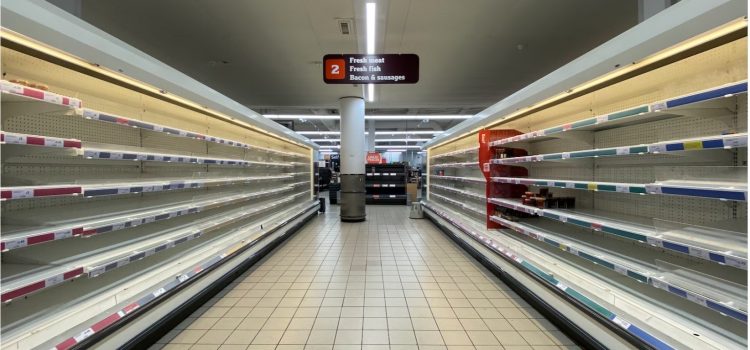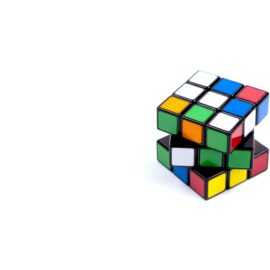
This is a free excerpt from one of Shortform’s Articles. We give you all the important information you need to know about current events and more.
Don't miss out on the whole story. Sign up for a free trial here .
How should you prepare for a disaster? What are the most important things to know?
The Covid-19 pandemic brought more than illness—it demonstrated the scarcity that can accompany a disaster. In its wake, and as climate change threatens more disruptions to supply chains as well as more severe weather events, society is discovering the importance of preparing for a disaster.
Read on to learn the eight most important ways to prepare for a disaster to keep you and your family safe.
How to Prepare for a Disaster
There are some easy and inexpensive ways to prepare for a disaster, while other ways require a substantial and perhaps ongoing investment of time and resources. How much should you prepare and which measures should you take? The optimal answer depends on your situation, values, and preferences, but there are a few principles that can help you find the optimal solution for your situation.
To address each basic need, there are a range of actions you could take, depending on how many resources you’re willing to commit to expanding your options in that area. Below, we’ll discuss the eight primary ways you can prepare for a disaster.
#1: Food
If you can’t buy food because supply chains have been disrupted, what are you going to eat? The simplest solution to prepare food supplies for a disaster is just to store food in your home.
The cost of this solution ranges from almost nothing to a significant investment, depending on how large of a food reserve you want to keep on hand: You can probably keep a week’s worth of food in your kitchen without any special considerations. If you want a month or more of reserves, you may want to set aside a closet or storage room for food storage. Ideally, it should be a room that will stay cool and dry but not freeze, even if the power goes off. However, some preppers who’ve got limited space make use of garages, garden sheds, and even crawl spaces.
Under these conditions, canned goods and dry foods like rice and pasta will usually stay fresh for at least a year, and some canned foods have been known to keep for decades. So you can keep a whole year or even several years’ worth of food on hand, if you have the money, the space, and the desire to do so.
While storing food is the most common solution, there are other things you can do to increase your options for obtaining food as well. Depending on where you live, you might be able to grow a garden, raise chickens, an increasingly popular practice, or keep milk goats and make your own dairy products. And you can also learn about foraging for edible plants and mushrooms that may grow in your area.
#2: Commodities
Any disaster that disrupts supply chains for food would also likely disrupt supply chains for other consumable products, like toilet paper, soap, toothpaste, deodorant, and feminine hygiene products. Sometimes, industry-specific upheavals may also create shortages of one or more of these products in isolation. To prepare for a disaster, as with food, keeping a supply of these on hand can help keep your options open. Most of these products have an infinite shelf life, so the only limit on how much you stockpile is how much money and space you’re willing to commit to preparedness.
Prepping Versus Panic Buying
Whenever the supply of a necessary good is reduced, people who are afraid of running out often race to buy up all they can. Panic buying results from a lack of preparedness, or a sudden realization that you’re not prepared for the crisis that is unfolding.
Panic buying creates a surge in demand as soon as the reduction in supply becomes apparent, exacerbating shortages, driving up prices, and in some cases necessitating preventative measures such as rationing.
But preppers exert a stabilizing influence on these market fluctuations: When other people start panic-buying a product and prices go up, preppers stop buying it, because there’s no point paying inflated prices during a transient shortage if you already have a three-year supply in your storeroom.
Sooner or later the market responds to higher prices by finding ways to expand production, eventually ending the shortage. More often than not, the suppliers will overshoot, and there will be a brief surplus right after the shortage, during which prices will drop below pre-shortage levels. This is when preppers restock. They benefit by paying less, on average, for the same product than non-preppers. And society benefits because they dampen the market fluctuations by refraining from purchasing during the shortage and then buying in large quantities during the surplus.
#3: Water
As with food and consumable commodities, it’s a good idea to have some bottled water stored for emergencies. Bottled water typically has a shelf life of one to two years. The water itself doesn’t spoil, but the plastic bottle may start to break down, making the water taste bad and eventually making the bottle leak.
In addition to keeping some drinkable water in storage, depending on where you live you can build redundancy into your water supply by drilling a private well, installing a rainwater collection system, or just having a way to carry water from a nearby source such as a lake or stream. However, it’s a good idea to have a sample from your prospective water source analyzed, because water collected by these methods is not necessarily safe to drink.
If the water contains viruses or bacteria, you can sterilize it by boiling it, filtering it, or treating it with disinfecting chemicals. This will kill any viruses and bacteria, but it won’t remove other contaminants, such as nitrates from agricultural runoff, heavy metals from mining operations, or other toxins from industrial waste. These contaminants can be removed by distillation or reverse osmosis.
#4: Electricity and Heat
Much of modern day-to-day life relies on electronic technology. How should you prepare for a disaster where the power grid went down for a day, a week, or a month? Maybe you could live without electricity. Maybe you’d even enjoy a break from electronic technology for a while. But having an independent source of electricity gives you more options in the event of a sustained power failure.
Spare batteries can keep some of your electronic devices operational for a while. To run appliances and other electrical devices that aren’t battery-powered, one option is to buy a gas or diesel generator. In this case, you’ll also need to store fuel for it. Another option is to install solar panels. If you live in a windy area, you can also install small wind turbines.
You can also find non-electric alternatives to fill some of the roles that electrical appliances are designed to fill. In particular, if you have electric heat, you could install a propane furnace, a pellet stove, or a wood-burning fireplace as a backup source of heat. Similarly, you could buy a portable propane stove or grill to cook on in the event that your regular stove is off-line for a while. Of course, to use appliances that run on fuels such as propane or wood, you’ll need to store a supply of fuel.
#5: Communications
If your phone and computer won’t connect to the network because a natural disaster has knocked out power and data networks in your area, how will you keep up with new developments? How will you communicate with loved ones outside your neighborhood?
To prepare for a disaster where communication networks no longer work, the most common solution is keeping a radio on hand. Any battery-powered or hand-crank radio receiver that gets the NOAA weather channels and standard AM/FM bands will allow you to tune in to news updates. If you want to transmit messages to other people via radio as well, you’ll probably need a HAM radio, which requires a license to operate.
#6: Transportation
If public transportation isn’t running, gas stations are out of gas, and the power grid is down, how would you get around? If you’ve got enough food, water, and other supplies to wait out the crisis at your own home, maybe you wouldn’t need to go anywhere. But again, mobility would give you more options in that situation.
A bicycle is a relatively inexpensive transportation solution that doesn’t rely on infrastructure to supply fuel or power. But compared to other vehicles, bicycles are slow and have limited space for cargo or passengers.
Another solution is to store your own reserve supply of fuel for a gasoline or diesel-powered vehicle. If you just make a practice of filling up on fuel before your tank is more than half-empty, you are, in effect, using the bottom half of your vehicle’s fuel tank as your reserve. This ensures that you could continue to drive for a little while after fuel supplies were cut off. You could increase the size of this reserve by storing fuel in portable gas cans or permanently-installed tanks, whether on your vehicle or at your home. You could store anywhere from five gallons to a thousand, depending on regulations and how much you’re willing to invest in reserve fuel and storage tanks.
Alternatively, if you have a source of electricity that’s independent of the power grid, you could continue to drive an electric vehicle.
Evacuating Versus Sheltering In Place
The need for transportation will be more significant if you decide to leave the affected area than if you stay put and wait out the crisis. In the event of a disaster, it’s a good idea to be prepared for both, since circumstances often dictate which one is more appropriate.
For example, if your home is threatened by a wildfire, your only viable option is to evacuate. On the other hand, if all the roads have been washed out by flash floods, sheltering in place may be your only option.
If both options are available, they each have their pros and cons. When you evacuate, you’re limited to what you can pack with you, whereas if you shelter in place, you’ll have access to all your possessions and stored-up supplies. Then again, if you shelter in place, you may have to live off your supplies for a longer time than if you temporarily relocate to an unaffected area.
To facilitate evacuation many preppers keep a “go bag” or “bug out bag” packed with enough food, water, clothing, medical supplies, spare cash, and other gear to live comfortably for at least three days. If you have to evacuate at a moment’s notice, you can just grab your bag and go.
Some preppers have a dedicated “bug out vehicle,” typically a van or pickup truck that acts as a mobile store room, stocked with emergency supplies. This is a relatively expensive option, but it arguably combines the benefit of sheltering in place (access to more supplies) with the ability to evacuate quickly if need be.
#7: Medicine
What would you do if you or someone you love needs medical attention, but normal health care services aren’t available? The scope of injuries and conditions that you can treat yourself is limited by both your level of medical training and the medical supplies at your disposal. At a minimum, you should keep a basic first aid kit and a supply of any medications that you take regularly (within the limits allowed by prescriptions).
If you want to take medical preparedness a step further, you could take classes in emergency medical response or other medical disciplines. Alternatively, you could study herbalism or other forms of traditional medicine and home remedies. All these things give you more options in the event that conventional medicine isn’t available when you need it.
#8: Security
Just as health care services may be shut down or overwhelmed during a crisis, so may law enforcement services. For that matter, if supply chains have been disrupted and people are running out of food or other necessities, people who still have food because they stored it up in advance become prime targets for theft. How should you prepare for disasters where it’s likely that someone will try to rob your home, and the police are not available to respond?
If you’ve kept your transportation options open, one possibility is to evacuate—preferably before you’re actually robbed. Another option is to confront the thief and defend yourself if necessary. If you consider that option appropriate, there are many defensive training programs available, whether you choose to train with firearms, other weapons, hand-to-hand martial arts, or all of the above.

Want to fast-track your learning? With Shortform, you’ll gain insights you won't find anywhere else .
Here's what you’ll get when you sign up for Shortform :
- Complicated ideas explained in simple and concise ways
- Smart analysis that connects what you’re reading to other key concepts
- Writing with zero fluff because we know how important your time is






